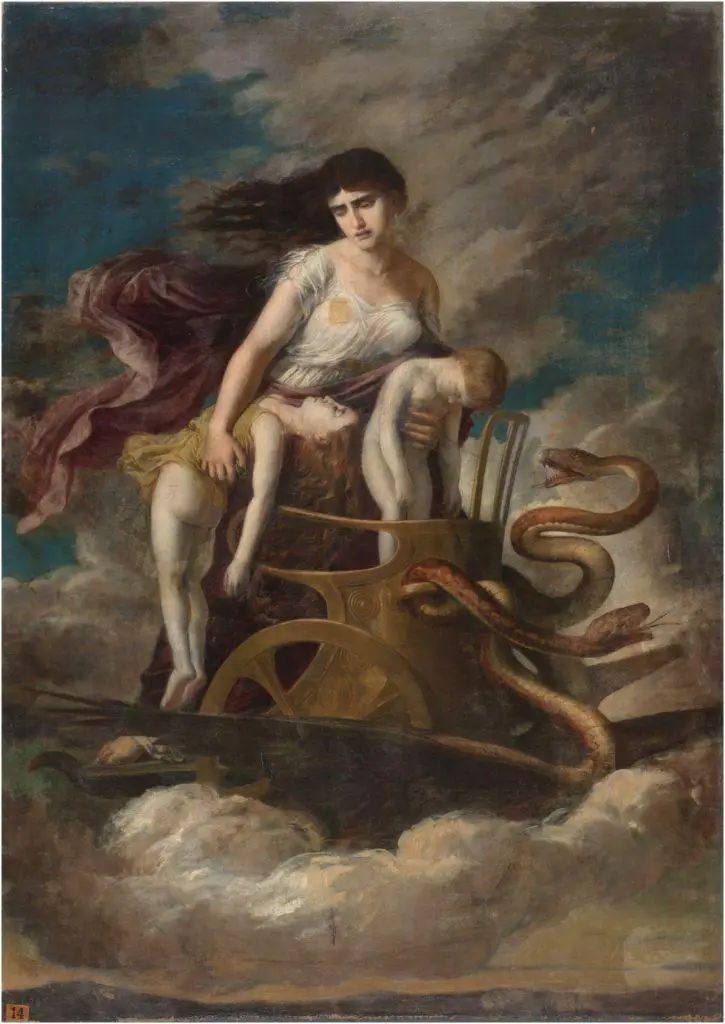Share the Lore!
By: Alex Postrado
Who Are the Witches of Greek Mythology?
When I say that witches go way back, I’m not talking about how William Shakespeare’s Weird Sisters from Macbeth championed the lasting image of witches in the early 1600s.
Nor am I referring to the real-life “great age of witch trials” which started in the 1500s.
No — to answer that, you would have to dig deeper.
As we know, witches have been enthralling mankind since the beginning of recorded history.
And there seems to be no exact answer as to where or when the concept of witches may have come into being.
But sources say that if you want to learn about the forerunners of the modern witch, Ancient Greece is a good place to start.
Because in between the myths of gods and tales of mortals, a handful of complex, powerful, and spellbinding witches are waiting to be found.
Ancient Greece and Witches
Witches appear in a lot of ancient cultures. But Ancient Greece was arguably the most notable cradle of the concept.
When we try to picture witches, we often conjure words like magic, powers, sin, cunning, wicked, hag, lust, or woman.
And parts of the reason for that can be found in the way ancient Greeks used to perceive things.
In the words of Aristotle, Ancient Greece believed that women were “evil” and “utterly useless” — that they “would bring disorder” and that they “caused more confusion than the enemy“.
This kind of mindset would — of course — translate, not only to the positions and roles of real women in their society but also to the characters they represent in Greek art and literature.
Most commonly, women were mere accessories to men-driven plotlines at their best.
And at their worst, they were literal villains that try to mess up the heroic narratives.
But the Greeks’ beliefs and entanglements in magic or mageia and sorcery or goeteia also put women — more specifically, those believed to practice witchcraft — on pedestals that got them both feared and worshipped.
Now, combine all of these factors and you have the unforgiving formula for the witches in Greek mythology.

The Witches in Greek Mythology
Hecate
No witchcraft-practicing being in Greek mythology was ever more venerated than the goddess of witchcraft, herself, Hecate.
First mentioned in the 7th century BCE in Hesiod’s Theogony, Hecate — also spelled Hekate — was said to be the daughter of the nymph Asteria with the Titan Perses.
She was the chief goddess of magic and spells, as well as the priestess of ghosts, necromancy, the moon, and the night.
She was also known for her varying form depending on the story.
A few examples of this would be her as a seductive maiden, a wizened hag, or a mysterious woman of childbearing age.
Similarly, the image of a torch-carrying woman, accompanied by black dogs is also a form associated with Hecate.
This stems from one of the goddess’ earliest appearances in Greek mythology — in the Gigantomachy, where she was believed to have slain the Giant Clytius with the use of her burning torch.
Moreover, along the same lines, her famous role in the abduction — and finding — of Persephone earned her the symbols of pillars, crossroads, and entranceways, as well as the image of an entity with three heads, each facing a different direction — making her a figure to call upon for help whenever someone gets lost.
Circe
A witch, a sorceress, an herbalist, a temptress — Circe was all of that.
And she was once also described as “the most beautiful of all mortal women” — despite her having the blood of an actual god flowing in her.
Most sources write that Circe was the daughter of the sun god Helios — with either the ocean nymph Perse or the goddess of witchcraft Hecate.
Nevertheless, she was best known for her dualistic role in Odysseus’ journey as told by the Odyssey, where she demonstrated her mastery in magical arts.
She lured people in, concocted potions, cast spells, and ultimately turned some of her victims into pigs.
At the same time, however, it was in this myth that she became one of Odysseus’ “greatest benefactors” — providing him and his men the crucial information about how they can safely navigate their return to Ithaca as they prepare to face the threats of the bewitching sirens, the monstrous Scylla, and the equally-threatening Charybdis.
Medea
A character related to both Hecate and Circe, Medea was believed to be a witch with the gift of seeing into the future.
While some scholars place her as a priestess of Hecate, others identify her as either Circe’s niece or sister.
That said, what sets Medea apart from the former two is the image she conjures — often hailed as “the complete opposite of what a woman should be”.
This label could be better understood through Medea’s part in Greek myth.
This prophecy-carrying witch first came into the picture when she — using her knowledge and magical prowess — aided Jason, the leader of the Argonauts, in his mission to obtain the magical Golden Fleece.
When victory was secured, the two proceeded to marry.
But the turning point for Medea eventually arose when Jason abandoned her so that he could wed King Creon’s daughter, Glauce — who Medea ultimately kills by lighting her on fire, along with the king and the entire castle.
As if all of that was not enough, Medea then seals the deal by taking hold of her children with Jason and stabbing them multiple times, leading to their tragic deaths.

Lamia
Lamia may be a witch, but she was also a child-devouring monster!
Having been notorious for those two things, who would have guessed that she was also once a beautiful and relatively innocent queen?
Yet things quickly — and devastatingly — took a turn for the worse for Lamia when she caught the wrath of the goddess Hera.
According to the ancient lore, after supposedly having an affair with Zeus, Hera turned Lamia into a serpentine chimera — with the head and breasts of a hauntingly attractive woman and the bottom half of a giant snake.
The curse came with a few abilities, though, as Lamia was said to have second sight, shapeshifting abilities, and a flair for witchcraft.
But at what cost? Well, two things.
Her eyes — both of which she tore out of her sockets in her descent into total insanity after seeing the fate of her own children.
And her children — whom she was forced to either butcher or eat alive, depending on the version of the story.
Pasiphaë
What is the best way to teach your cheating partner their well-deserved lesson?
For Pasiphaë, it was by using magic to make her husband, King Minos, ejaculate snakes, millipedes, and scorpions every time he sleeps with other women.
The sister of Circe and the daughter of Helios and Perse — Pasiphaë undoubtedly came from a line of names that are nothing short of recognized.
Unfortunately for her, in Greek mythology, she became best known, neither for her bloodline nor her skills in sorcery, but for a curse placed upon her by the sea god Poseidon.
As the lore goes, every year, the kingdom of Crete was required to sacrifice “the fairest bull born in its herd” to Poseidon.
But when the day came that Minos refused to surrender a rarely handsome bull, called the Cretan bull, it was Pasiphaë who fell victim to the god’s wretched punishment:
She was doomed to lust after the Cretan bull!
And not just that — to mate with it, to ultimately carry its son, the Minotaur.
To Fear or to Worship?
While those make up the more famous names, there are still several — albeit lesser-known — witches in Greek mythology that also deserve to be mentioned.
Witches, like the Graeae — otherwise known as the Grey Sisters or the Stygian Witches, composed of Deino, Enyo, and Pemphredo — who were believed to share one eye and one tooth between them.
The Telchines — the magicians and smiths of the island of Rhodes, and the inventors of metalworking.
Agamede — referred to, by some, as Perimede — the fair-haired witch and herb expert from the Hellenistic period.
Or Thrace — the eponymous sorceress from the region of Thrace.
A few others might have still been missed, but the main takeaway from all of these witch stories is that — much like the witch character, itself — they are cultural metaphors centered around our ancient views and attitude toward female authority.
The fact that, although we, sometimes, admire the power, other times, we fear that it may be used against us.
But, just as most of the stories here, when we look closely, we would see that power is — in general — a double-edged sword.
It could be the cause of our fame or the root of our downfall.
And as for the witches of Greek mythology, it — oftentimes — dictated their places in their lore.
Whether they would be characters that people would cower before or the ones that are written to be looked up to.
References:
Creature Feature: A History Of Witches Within Literature Magic In Ancient Greece Witches Of The Ancient World 'animagi,' Dragons, And Greek Witches Maiden, Mother, Crone: Everything You Need To Know About Hecate Witches In History And Legend: Circe, The Mistress Of Natural Magic And Metamorphosis The Myth Of Medea, A Sorceress In Love Agamede - Elean Princess & Witch Of Greek Mythology Pasiphae: Daughter Of The Sun, Wife Of A King, And Mother Of The Minotaur Telchines - Occult World Lamia - Mythology

